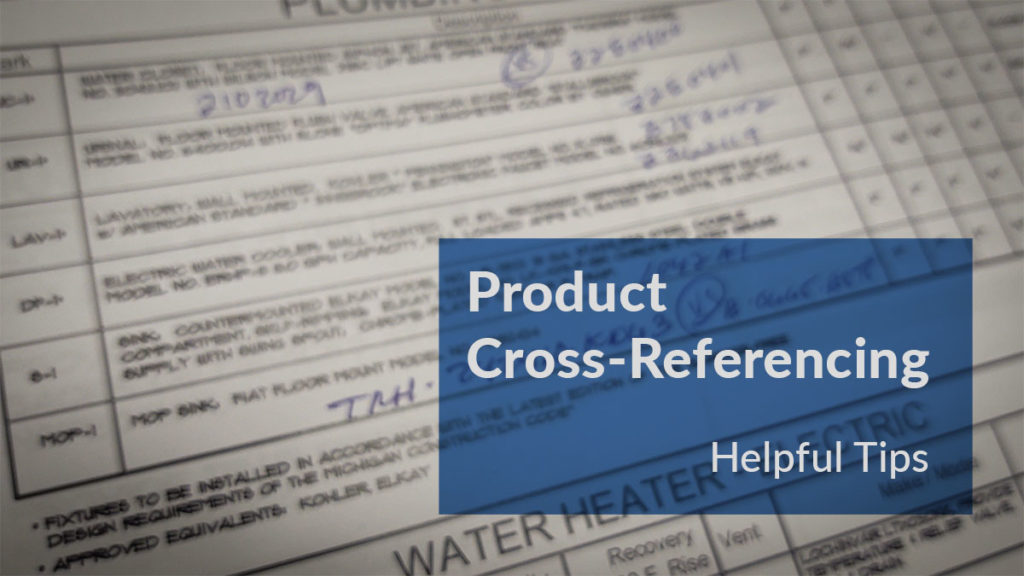
If you have ever tried to find a product from one manufacturer and find its equal at another company, then you know how challenging it can be at times. First of all, the sheer number of products and options available to consumers is staggering. One manufacturer alone may produce thousands of products, each with its own set of options. Additionally, as plumbing products become more complex, more knowledge is needed, and there are more nuances to consider. Finally, as competition fuels innovation, some products are unique within their category, and an exact match simply cannot be obtained.
In my 10+ years of experience doing product crosses all day and every day at work, I learned that crossing is part art and part science; a good sense of judgment and a good workflow produce the best results. What I share in this article is not a set of hard and fast rules or an inexhaustible guide, but rather my own personal approach to crossing products that have served me well over the years.
1. Know the Basics of Your Product Category
When I was just starting out, crossing something I knew next to nothing about always gave me an uneasy feeling. I felt like saying a prayer every time I sent my quote off. But as with all complex skills, as your knowledge and experience increase, you will gain more confidence.
If you feel this way, reach out for help inside or outside your company (that’s what manufacturers reps are here for, after all). At the very least, a quick Google search can suffice, And although it may not be able to provide you with in-depth knowledge, it can give you a basic understanding of how things work in a short amount of time. Some products are more straightforward than others, and the more complex the product is, the more time it will take to learn the ins and outs of that category.
2. Read Carefully
Force yourself to slow down. Read each sentence backward if you have to. Whatever it takes. If you’re reading from a plumbing schedule description or a written set of specifications, then take time to make comparisons between the two.
Next, get online and search for the product submittal, and then compare that to what’s on your schedules and specs. I find a lot of mistakes this way. If there are any discrepancies, make a note of them. As a general rule of thumb, the product description on the plumbing schedule is most likely what the engineer is looking for (this trumps model numbers and written specifications, which are frequently cut and pasted).
3. Think Like Google
Keywords! The world runs on keywords! This is true not only in the digital world, but it is true of our brains as well. I was taught early on to read through a product description and highlight the keywords I thought were important. Boy, is this helpful! Over time, your will be able to quickly spot essential data. Important keywords to highlight will pertain to the form or function of the product, which brings me to my next point…

4. How to Think About the Products Your Comparing
It’s helpful to think about a product in terms of attributes and behaviors. Attributes are qualities has, while behaviors are things it does. Form and function are another way of referring to these concepts. Here are some examples of each:
Examples of “form” include:
- Product materials
- Special finishes
- Design aesthetics
- Dimensions
- Mounting sizes
Examples of “function” include:
- Flow-rate
- Flush-volume
- Vandal-resistance
- Service shut-off mechanisms
- Bluetooth connectivity
Finally, the last category to compare two products is price-point. In an ideal world, the price wouldn’t matter, and everyone would be able to pick the best product for their application. In reality, budgets are tight, and the price is often the deciding factor.

If you can, try to find the list price of the product you’re crossing. Often it is displayed right on the manufacturer’s website. Make sure the cost of your product is in the same ballpark as your competitors.
If it’s not, you should be asking yourself why – perhaps you made a mistake? Is there some aspect of your product that is better than the competition and thus justifies a higher price point? Whatever the reason, you need to know why and either offer a different product or explain the difference to your customer.
6. Utilize manufacturer tools
Often, a manufacturer will have ever-so handy cross-reference guides in the resources section of their website. These can be incredibly helpful, though, in my experience, you can’t rely on them entirely; they will get you 90%-95% of the way there most times. It is still up to you to carefully read the descriptions and include any product options that may be standard on a competitor’s product but not your own.

Filters are your friends! Make good use of them! On many websites (like T&S Brass), the filters are a handy way to narrow down product choices by a wide array of features. From there, it is only a matter of deciding between a few products instead of hundreds or even thousands.
7. Make Your Customer Aware of Any Differences
As stated earlier, it is important to note any potential differences between your product and the competitors. Very seldom are two products indeed “apples-to-apples.”
While sometimes frustrating, it is your responsibility to be transparent with your customer. Differences can even open lines of communication with your customers and allow you to determine what features are essential to them vs. simply ‘nice-to-have.’
8. A Note on Your Surroundings
Where you work can have just as much influence on your accuracy as your methods. Product crossing (and quoting) is like taking an exam (an exam you are expected to get 100% right every time).
Therefore, make sure your environment is as distraction-free as possible. The notion of multitasking has been well-researched and well-disproven; it’s really only rapid context switching and wreaks havoc on your concentration. With that in mind, do whatever is within your control to optimize your environment, and you’ll significantly improve your accuracy and speed.
(for my money, an optimal environment is quiet and has a good strong cup of coffee within arms reach) 😉

There you have it. These are my basic guidelines for product crossing based on my experience in the trenches. I hope they prove helpful to you the next time you find yourself crossing products. And if you need any help along the way, by all means, contact us, and we’ll help you out. If you have additional tips or insights that I can add to my arsenal of knowledge, be sure to share them as well!

